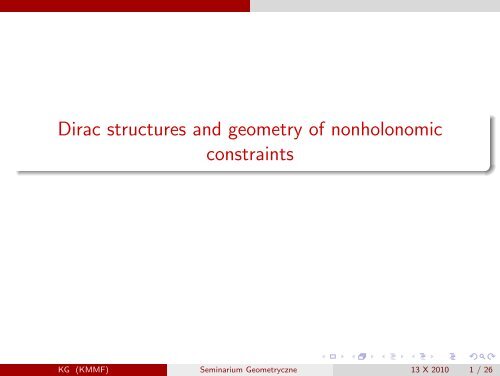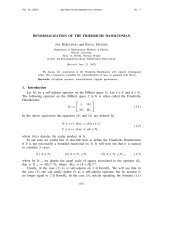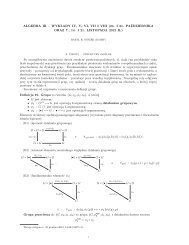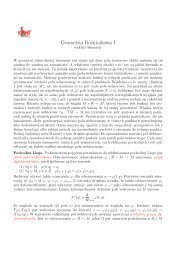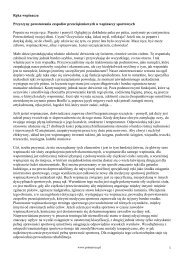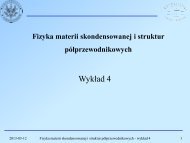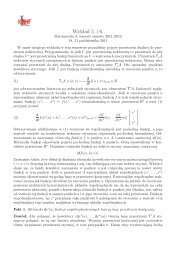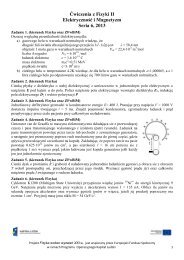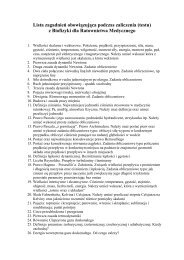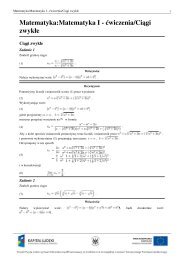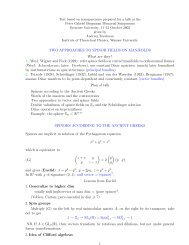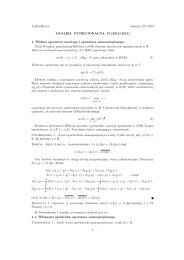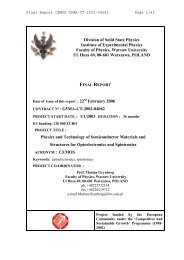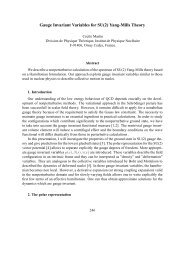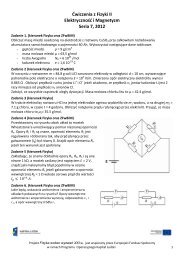Dirac structures and geometry of nonholonomic constraints
Dirac structures and geometry of nonholonomic constraints
Dirac structures and geometry of nonholonomic constraints
Create successful ePaper yourself
Turn your PDF publications into a flip-book with our unique Google optimized e-Paper software.
<strong>Dirac</strong> <strong>structures</strong> <strong>and</strong> <strong>geometry</strong> <strong>of</strong> <strong>nonholonomic</strong><br />
<strong>constraints</strong><br />
KG (KMMF) Seminarium Geometryczne 13 X 2010 1 / 26
Introduction<br />
References<br />
Hiroaki Yoshimura, Jerrold E. Marsden : ”<strong>Dirac</strong> <strong>structures</strong> in<br />
Lagrangian Mechanics”, J. Geom. Phys., 57, (2006) Part I 133–156,<br />
Part II 209-250;<br />
W̷lodzimierz M. Tulczyjew: ”A note on holonomic <strong>constraints</strong>” in<br />
Revisiting the Foundations <strong>of</strong> Relativistic Physics, A. Ashtekar et. al.<br />
(eds.), 403-419, 2003 Kluver Academic Press;<br />
Katarzyna Grabowska, Janusz Grabowski: ”Variational calculus with<br />
<strong>constraints</strong> on general algebroids”, J. Phys. A: Math. Theor. 41,<br />
(2008).<br />
KG (KMMF) Seminarium Geometryczne 13 X 2010 2 / 26
Introduction<br />
References<br />
Hiroaki Yoshimura, Jerrold E. Marsden : ”<strong>Dirac</strong> <strong>structures</strong> in<br />
Lagrangian Mechanics”, J. Geom. Phys., 57, (2006) Part I 133–156,<br />
Part II 209-250;<br />
W̷lodzimierz M. Tulczyjew: ”A note on holonomic <strong>constraints</strong>” in<br />
Revisiting the Foundations <strong>of</strong> Relativistic Physics, A. Ashtekar et. al.<br />
(eds.), 403-419, 2003 Kluver Academic Press;<br />
Katarzyna Grabowska, Janusz Grabowski: ”Variational calculus with<br />
<strong>constraints</strong> on general algebroids”, J. Phys. A: Math. Theor. 41,<br />
(2008).<br />
KG (KMMF) Seminarium Geometryczne 13 X 2010 2 / 26
Introduction<br />
References<br />
Hiroaki Yoshimura, Jerrold E. Marsden : ”<strong>Dirac</strong> <strong>structures</strong> in<br />
Lagrangian Mechanics”, J. Geom. Phys., 57, (2006) Part I 133–156,<br />
Part II 209-250;<br />
W̷lodzimierz M. Tulczyjew: ”A note on holonomic <strong>constraints</strong>” in<br />
Revisiting the Foundations <strong>of</strong> Relativistic Physics, A. Ashtekar et. al.<br />
(eds.), 403-419, 2003 Kluver Academic Press;<br />
Katarzyna Grabowska, Janusz Grabowski: ”Variational calculus with<br />
<strong>constraints</strong> on general algebroids”, J. Phys. A: Math. Theor. 41,<br />
(2008).<br />
KG (KMMF) Seminarium Geometryczne 13 X 2010 2 / 26
Contents<br />
<strong>Dirac</strong> structure<br />
<strong>Dirac</strong> structure on T ∗ Q induced by a distribution on Q.<br />
Nonholonomic <strong>constraints</strong> <strong>and</strong> <strong>Dirac</strong> <strong>structures</strong> according to Y & M<br />
My point <strong>of</strong> view<br />
Comments about the terminology (<strong>and</strong> example)<br />
KG (KMMF) Seminarium Geometryczne 13 X 2010 3 / 26
Contents<br />
<strong>Dirac</strong> structure<br />
<strong>Dirac</strong> structure on T ∗ Q induced by a distribution on Q.<br />
Nonholonomic <strong>constraints</strong> <strong>and</strong> <strong>Dirac</strong> <strong>structures</strong> according to Y & M<br />
My point <strong>of</strong> view<br />
Comments about the terminology (<strong>and</strong> example)<br />
KG (KMMF) Seminarium Geometryczne 13 X 2010 3 / 26
Contents<br />
<strong>Dirac</strong> structure<br />
<strong>Dirac</strong> structure on T ∗ Q induced by a distribution on Q.<br />
Nonholonomic <strong>constraints</strong> <strong>and</strong> <strong>Dirac</strong> <strong>structures</strong> according to Y & M<br />
My point <strong>of</strong> view<br />
Comments about the terminology (<strong>and</strong> example)<br />
KG (KMMF) Seminarium Geometryczne 13 X 2010 3 / 26
Contents<br />
<strong>Dirac</strong> structure<br />
<strong>Dirac</strong> structure on T ∗ Q induced by a distribution on Q.<br />
Nonholonomic <strong>constraints</strong> <strong>and</strong> <strong>Dirac</strong> <strong>structures</strong> according to Y & M<br />
My point <strong>of</strong> view<br />
Comments about the terminology (<strong>and</strong> example)<br />
KG (KMMF) Seminarium Geometryczne 13 X 2010 3 / 26
Contents<br />
<strong>Dirac</strong> structure<br />
<strong>Dirac</strong> structure on T ∗ Q induced by a distribution on Q.<br />
Nonholonomic <strong>constraints</strong> <strong>and</strong> <strong>Dirac</strong> <strong>structures</strong> according to Y & M<br />
My point <strong>of</strong> view<br />
Comments about the terminology (<strong>and</strong> example)<br />
KG (KMMF) Seminarium Geometryczne 13 X 2010 3 / 26
<strong>Dirac</strong> structure<br />
Definition<br />
A <strong>Dirac</strong> structure L on a manifold M is a vector subbundle <strong>of</strong><br />
TM ⊕M T ∗ M which is maximal isotropic with respect to the metric<br />
〈Xp + ϕp | Yp + ψp〉 = 1<br />
2 (〈ψp, Xp〉 + 〈ϕp, Yp〉)<br />
<strong>and</strong> involutve with respect to Dorfman bracket<br />
[X + ϕ, Y + ψ]D = [X , Y ] + (LX ψ − ıY dϕ).<br />
We call L an almost <strong>Dirac</strong> structure when it is maximal isotropic <strong>and</strong> not<br />
involutive.<br />
KG (KMMF) Seminarium Geometryczne 13 X 2010 4 / 26
<strong>Dirac</strong> structure<br />
Definition<br />
A <strong>Dirac</strong> structure L on a manifold M is a vector subbundle <strong>of</strong><br />
TM ⊕M T ∗ M which is maximal isotropic with respect to the metric<br />
〈Xp + ϕp | Yp + ψp〉 = 1<br />
2 (〈ψp, Xp〉 + 〈ϕp, Yp〉)<br />
<strong>and</strong> involutve with respect to Dorfman bracket<br />
[X + ϕ, Y + ψ]D = [X , Y ] + (LX ψ − ıY dϕ).<br />
We call L an almost <strong>Dirac</strong> structure when it is maximal isotropic <strong>and</strong> not<br />
involutive.<br />
KG (KMMF) Seminarium Geometryczne 13 X 2010 4 / 26
Almost <strong>Dirac</strong> structure in mechanics<br />
M = T ∗ Q, symplectic form ωQ, associated map βQ:<br />
βQ : TT ∗ Q −→ T ∗ T ∗ Q, β(w) = ωQ(·, w)<br />
∆Q ⊂ TQ is a regular distribution not necessarily involutive,<br />
representing (<strong>nonholonomic</strong>) <strong>constraints</strong>,<br />
∆ ◦ Q ⊂ T∗ Q is an anihilator <strong>of</strong> ∆Q,<br />
πQ : T ∗ Q −→ Q<br />
TπQ : TT ∗ Q −→ TQ<br />
∆T ∗ Q = (TπQ) −1 (∆Q) is a regular distribution on T ∗ Q<br />
∆ ◦ T ∗ Q is an anihilator <strong>of</strong> ∆T ∗ Q,<br />
KG (KMMF) Seminarium Geometryczne 13 X 2010 5 / 26
Almost <strong>Dirac</strong> structure in mechanics<br />
M = T ∗ Q, symplectic form ωQ, associated map βQ:<br />
βQ : TT ∗ Q −→ T ∗ T ∗ Q, β(w) = ωQ(·, w)<br />
∆Q ⊂ TQ is a regular distribution not necessarily involutive,<br />
representing (<strong>nonholonomic</strong>) <strong>constraints</strong>,<br />
∆ ◦ Q ⊂ T∗ Q is an anihilator <strong>of</strong> ∆Q,<br />
πQ : T ∗ Q −→ Q<br />
TπQ : TT ∗ Q −→ TQ<br />
∆T ∗ Q = (TπQ) −1 (∆Q) is a regular distribution on T ∗ Q<br />
∆ ◦ T ∗ Q is an anihilator <strong>of</strong> ∆T ∗ Q,<br />
KG (KMMF) Seminarium Geometryczne 13 X 2010 5 / 26
Almost <strong>Dirac</strong> structure in mechanics<br />
M = T ∗ Q, symplectic form ωQ, associated map βQ:<br />
βQ : TT ∗ Q −→ T ∗ T ∗ Q, β(w) = ωQ(·, w)<br />
∆Q ⊂ TQ is a regular distribution not necessarily involutive,<br />
representing (<strong>nonholonomic</strong>) <strong>constraints</strong>,<br />
∆ ◦ Q ⊂ T∗ Q is an anihilator <strong>of</strong> ∆Q,<br />
πQ : T ∗ Q −→ Q<br />
TπQ : TT ∗ Q −→ TQ<br />
∆T ∗ Q = (TπQ) −1 (∆Q) is a regular distribution on T ∗ Q<br />
∆ ◦ T ∗ Q is an anihilator <strong>of</strong> ∆T ∗ Q,<br />
KG (KMMF) Seminarium Geometryczne 13 X 2010 5 / 26
Almost <strong>Dirac</strong> structure in mechanics<br />
M = T ∗ Q, symplectic form ωQ, associated map βQ:<br />
βQ : TT ∗ Q −→ T ∗ T ∗ Q, β(w) = ωQ(·, w)<br />
∆Q ⊂ TQ is a regular distribution not necessarily involutive,<br />
representing (<strong>nonholonomic</strong>) <strong>constraints</strong>,<br />
∆ ◦ Q ⊂ T∗ Q is an anihilator <strong>of</strong> ∆Q,<br />
πQ : T ∗ Q −→ Q<br />
TπQ : TT ∗ Q −→ TQ<br />
∆T ∗ Q = (TπQ) −1 (∆Q) is a regular distribution on T ∗ Q<br />
∆ ◦ T ∗ Q is an anihilator <strong>of</strong> ∆T ∗ Q,<br />
KG (KMMF) Seminarium Geometryczne 13 X 2010 5 / 26
Almost <strong>Dirac</strong> structure in mechanics<br />
M = T ∗ Q, symplectic form ωQ, associated map βQ:<br />
βQ : TT ∗ Q −→ T ∗ T ∗ Q, β(w) = ωQ(·, w)<br />
∆Q ⊂ TQ is a regular distribution not necessarily involutive,<br />
representing (<strong>nonholonomic</strong>) <strong>constraints</strong>,<br />
∆ ◦ Q ⊂ T∗ Q is an anihilator <strong>of</strong> ∆Q,<br />
πQ : T ∗ Q −→ Q<br />
TπQ : TT ∗ Q −→ TQ<br />
∆T ∗ Q = (TπQ) −1 (∆Q) is a regular distribution on T ∗ Q<br />
∆ ◦ T ∗ Q is an anihilator <strong>of</strong> ∆T ∗ Q,<br />
KG (KMMF) Seminarium Geometryczne 13 X 2010 5 / 26
Almost <strong>Dirac</strong> structure in mechanics<br />
M = T ∗ Q, symplectic form ωQ, associated map βQ:<br />
βQ : TT ∗ Q −→ T ∗ T ∗ Q, β(w) = ωQ(·, w)<br />
∆Q ⊂ TQ is a regular distribution not necessarily involutive,<br />
representing (<strong>nonholonomic</strong>) <strong>constraints</strong>,<br />
∆ ◦ Q ⊂ T∗ Q is an anihilator <strong>of</strong> ∆Q,<br />
πQ : T ∗ Q −→ Q<br />
TπQ : TT ∗ Q −→ TQ<br />
∆T ∗ Q = (TπQ) −1 (∆Q) is a regular distribution on T ∗ Q<br />
∆ ◦ T ∗ Q is an anihilator <strong>of</strong> ∆T ∗ Q,<br />
KG (KMMF) Seminarium Geometryczne 13 X 2010 5 / 26
Almost <strong>Dirac</strong> <strong>structures</strong> in mechanics<br />
Definition<br />
The almost <strong>Dirac</strong> structure on T ∗ Q induced by a distribution ∆Q is the<br />
subbundle<br />
∆ ⊂ TT ∗ Q ⊕T ∗ Q T ∗ T ∗ Q<br />
∆ = {w + ϕ : w ∈ ∆T ∗ Q, ϕ − βQ(w) ∈ ∆ ◦ T ∗ Q }<br />
If ∆Q = TQ then ∆T ∗ Q = TT ∗ Q <strong>and</strong> ∆ is the graph <strong>of</strong> βQ.<br />
If ∆Q is involutive then ∆ is a true <strong>Dirac</strong> structure.<br />
KG (KMMF) Seminarium Geometryczne 13 X 2010 6 / 26
Almost <strong>Dirac</strong> <strong>structures</strong> in mechanics<br />
Definition<br />
The almost <strong>Dirac</strong> structure on T ∗ Q induced by a distribution ∆Q is the<br />
subbundle<br />
∆ ⊂ TT ∗ Q ⊕T ∗ Q T ∗ T ∗ Q<br />
∆ = {w + ϕ : w ∈ ∆T ∗ Q, ϕ − βQ(w) ∈ ∆ ◦ T ∗ Q }<br />
If ∆Q = TQ then ∆T ∗ Q = TT ∗ Q <strong>and</strong> ∆ is the graph <strong>of</strong> βQ.<br />
If ∆Q is involutive then ∆ is a true <strong>Dirac</strong> structure.<br />
KG (KMMF) Seminarium Geometryczne 13 X 2010 6 / 26
Almost <strong>Dirac</strong> <strong>structures</strong> in mechanics<br />
Definition<br />
The almost <strong>Dirac</strong> structure on T ∗ Q induced by a distribution ∆Q is the<br />
subbundle<br />
∆ ⊂ TT ∗ Q ⊕T ∗ Q T ∗ T ∗ Q<br />
∆ = {w + ϕ : w ∈ ∆T ∗ Q, ϕ − βQ(w) ∈ ∆ ◦ T ∗ Q }<br />
If ∆Q = TQ then ∆T ∗ Q = TT ∗ Q <strong>and</strong> ∆ is the graph <strong>of</strong> βQ.<br />
If ∆Q is involutive then ∆ is a true <strong>Dirac</strong> structure.<br />
KG (KMMF) Seminarium Geometryczne 13 X 2010 6 / 26
Almost <strong>Dirac</strong> <strong>structures</strong> in mechanics<br />
Local expressions: For O being an open subset <strong>of</strong> Q we identify<br />
TO O × V ∋ (q, ˙q),<br />
T ∗ O O × V ∗ ∋ (q, p),<br />
TT ∗ O O × V ∗ × V × V ∗ ∋ (q, p, ˙q, ˙p) = w,<br />
T ∗ T ∗ O O × V ∗ × V ∗ × V ∋ (q, p, a, b) = ϕ.<br />
∆Q = {(q, ˙q) : ˙q ∈ ∆Q(q)}, ∆Q(q) ⊂ V ,<br />
∆ ◦ Q = {(q, ˙q) : ˙q ∈ ∆◦ Q (q)}, ∆◦ Q (q) ⊂ V ∗ ,<br />
∆T ∗ Q = {(q, p, ˙q, ˙p) : ˙q ∈ ∆Q(q)},<br />
∆ ◦ T∗Q = {(q, p, a, b) : a ∈ ∆◦Q (q), b = 0}.<br />
∆ = {(q, p, ˙q, ˙p, a, b) : ˙q ∈ ∆Q(q), a + ˙p ∈ ∆ ◦ Q (q), b = ˙q}.<br />
KG (KMMF) Seminarium Geometryczne 13 X 2010 7 / 26
Almost <strong>Dirac</strong> <strong>structures</strong> in mechanics<br />
Local expressions: For O being an open subset <strong>of</strong> Q we identify<br />
TO O × V ∋ (q, ˙q),<br />
T ∗ O O × V ∗ ∋ (q, p),<br />
TT ∗ O O × V ∗ × V × V ∗ ∋ (q, p, ˙q, ˙p) = w,<br />
T ∗ T ∗ O O × V ∗ × V ∗ × V ∋ (q, p, a, b) = ϕ.<br />
∆Q = {(q, ˙q) : ˙q ∈ ∆Q(q)}, ∆Q(q) ⊂ V ,<br />
∆ ◦ Q = {(q, ˙q) : ˙q ∈ ∆◦ Q (q)}, ∆◦ Q (q) ⊂ V ∗ ,<br />
∆T ∗ Q = {(q, p, ˙q, ˙p) : ˙q ∈ ∆Q(q)},<br />
∆ ◦ T∗Q = {(q, p, a, b) : a ∈ ∆◦Q (q), b = 0}.<br />
∆ = {(q, p, ˙q, ˙p, a, b) : ˙q ∈ ∆Q(q), a + ˙p ∈ ∆ ◦ Q (q), b = ˙q}.<br />
KG (KMMF) Seminarium Geometryczne 13 X 2010 7 / 26
Almost <strong>Dirac</strong> <strong>structures</strong> in mechanics<br />
Local expressions: For O being an open subset <strong>of</strong> Q we identify<br />
TO O × V ∋ (q, ˙q),<br />
T ∗ O O × V ∗ ∋ (q, p),<br />
TT ∗ O O × V ∗ × V × V ∗ ∋ (q, p, ˙q, ˙p) = w,<br />
T ∗ T ∗ O O × V ∗ × V ∗ × V ∋ (q, p, a, b) = ϕ.<br />
∆Q = {(q, ˙q) : ˙q ∈ ∆Q(q)}, ∆Q(q) ⊂ V ,<br />
∆ ◦ Q = {(q, ˙q) : ˙q ∈ ∆◦ Q (q)}, ∆◦ Q (q) ⊂ V ∗ ,<br />
∆T ∗ Q = {(q, p, ˙q, ˙p) : ˙q ∈ ∆Q(q)},<br />
∆ ◦ T∗Q = {(q, p, a, b) : a ∈ ∆◦Q (q), b = 0}.<br />
∆ = {(q, p, ˙q, ˙p, a, b) : ˙q ∈ ∆Q(q), a + ˙p ∈ ∆ ◦ Q (q), b = ˙q}.<br />
KG (KMMF) Seminarium Geometryczne 13 X 2010 7 / 26
Constrained Lagrangian system according to Y & M<br />
Let L : TQ → R be a Lagrangian (possibly not hyperregular).<br />
T∗TQ ζ<br />
⑤⑤⑤⑤⑤⑤⑤⑤⑤<br />
❆<br />
π ❆ TQ ❆<br />
<br />
T∗Q❇ TQ<br />
❇<br />
πQ τQ ❇<br />
<br />
⑥⑥⑥⑥⑥⑥⑥⑥⑥<br />
<br />
❲<br />
❆dL<br />
✮<br />
★<br />
❴<br />
❴ ❴ ❴ FL❴<br />
❴ ❴ ❴<br />
Q<br />
Definition<br />
The Legendre map FL : TQ → T ∗ Q is defined by the formula<br />
FL = ζ ◦ dL.<br />
KG (KMMF) Seminarium Geometryczne 13 X 2010 8 / 26
Constrained Lagrangian system according to Y & M<br />
Let L : TQ → R be a Lagrangian (possibly not hyperregular).<br />
T∗TQ ζ<br />
⑤⑤⑤⑤⑤⑤⑤⑤⑤<br />
❆<br />
π ❆ TQ ❆<br />
<br />
T∗Q❇ TQ<br />
❇<br />
πQ τQ ❇<br />
<br />
⑥⑥⑥⑥⑥⑥⑥⑥⑥<br />
<br />
❲<br />
❆dL<br />
✮<br />
★<br />
❴<br />
❴ ❴ ❴ FL❴<br />
❴ ❴ ❴<br />
Q<br />
Definition<br />
The Legendre map FL : TQ → T ∗ Q is defined by the formula<br />
FL = ζ ◦ dL.<br />
KG (KMMF) Seminarium Geometryczne 13 X 2010 8 / 26
Constrained Lagrangian system according to Y & M<br />
There exists the canonical isomorphism<br />
Locally for O ⊂ Q we have<br />
<strong>and</strong><br />
γQ : T ∗ TQ −→ T ∗ T ∗ Q<br />
T ∗ TO O × V × V ∗ × V ∗ , T ∗ T ∗ O O × V ∗ × V ∗ × V<br />
γQ(q, ˙q, c, d) = (q, d, −c, ˙q)<br />
It exists for any vector bundle (not only tangent bundle), it is a double<br />
vector bundle isomorphism <strong>and</strong> antisymplectomorphism.<br />
KG (KMMF) Seminarium Geometryczne 13 X 2010 9 / 26
Constrained Lagrangian system according to Y & M<br />
Definition<br />
For L : TQ → R the composition<br />
γQ ◦ dL : TQ −→ T ∗ T ∗ Q<br />
will be called the <strong>Dirac</strong> differential <strong>of</strong> L <strong>and</strong> denoted by DL<br />
Locally:<br />
DL(q, ˙q) = (q, ∂L<br />
, −∂L , ˙q)<br />
∂ ˙q ∂q<br />
KG (KMMF) Seminarium Geometryczne 13 X 2010 10 / 26
Constrained Lagrangian system according to Y & M<br />
Definition<br />
A partial vector field on T ∗ Q is a map<br />
such that<br />
X : TQ ⊕Q T ∗ Q −→ TT ∗ Q<br />
X (v, p) ∈ TpT ∗ Q.<br />
KG (KMMF) Seminarium Geometryczne 13 X 2010 11 / 26
Constrained Lagrangian system according to Y & M<br />
A Lagrangian system with <strong>nonholonomic</strong> <strong>constraints</strong> ∆Q can be described<br />
by a triple<br />
(L, ∆, X )<br />
where<br />
L is a Lagrangian function, possibly not hyperregular,<br />
∆ is the <strong>Dirac</strong> structure associated to the constraint distribution ∆Q,<br />
X is a partial vector field defined in points<br />
<strong>and</strong> such that<br />
(v, p) ∈ TQ ⊕ T ∗ Q, such that v ∈ ∆Q, p = FL(v)<br />
X (v, p) + DL(v) ∈ ∆<br />
KG (KMMF) Seminarium Geometryczne 13 X 2010 12 / 26
Constrained Lagrangian system according to Y & M<br />
A Lagrangian system with <strong>nonholonomic</strong> <strong>constraints</strong> ∆Q can be described<br />
by a triple<br />
(L, ∆, X )<br />
where<br />
L is a Lagrangian function, possibly not hyperregular,<br />
∆ is the <strong>Dirac</strong> structure associated to the constraint distribution ∆Q,<br />
X is a partial vector field defined in points<br />
<strong>and</strong> such that<br />
(v, p) ∈ TQ ⊕ T ∗ Q, such that v ∈ ∆Q, p = FL(v)<br />
X (v, p) + DL(v) ∈ ∆<br />
KG (KMMF) Seminarium Geometryczne 13 X 2010 12 / 26
Constrained Lagrangian system according to Y & M<br />
A Lagrangian system with <strong>nonholonomic</strong> <strong>constraints</strong> ∆Q can be described<br />
by a triple<br />
(L, ∆, X )<br />
where<br />
L is a Lagrangian function, possibly not hyperregular,<br />
∆ is the <strong>Dirac</strong> structure associated to the constraint distribution ∆Q,<br />
X is a partial vector field defined in points<br />
<strong>and</strong> such that<br />
(v, p) ∈ TQ ⊕ T ∗ Q, such that v ∈ ∆Q, p = FL(v)<br />
X (v, p) + DL(v) ∈ ∆<br />
KG (KMMF) Seminarium Geometryczne 13 X 2010 12 / 26
Constrained Lagrangian system according to Y & M<br />
A Lagrangian system with <strong>nonholonomic</strong> <strong>constraints</strong> ∆Q can be described<br />
by a triple<br />
(L, ∆, X )<br />
where<br />
L is a Lagrangian function, possibly not hyperregular,<br />
∆ is the <strong>Dirac</strong> structure associated to the constraint distribution ∆Q,<br />
X is a partial vector field defined in points<br />
<strong>and</strong> such that<br />
(v, p) ∈ TQ ⊕ T ∗ Q, such that v ∈ ∆Q, p = FL(v)<br />
X (v, p) + DL(v) ∈ ∆<br />
KG (KMMF) Seminarium Geometryczne 13 X 2010 12 / 26
Constrained Lagrangian system according to Y & M<br />
A Lagrangian system with <strong>nonholonomic</strong> <strong>constraints</strong> ∆Q can be described<br />
by a triple<br />
(L, ∆, X )<br />
where<br />
L is a Lagrangian function, possibly not hyperregular,<br />
∆ is the <strong>Dirac</strong> structure associated to the constraint distribution ∆Q,<br />
X is a partial vector field defined in points<br />
<strong>and</strong> such that<br />
(v, p) ∈ TQ ⊕ T ∗ Q, such that v ∈ ∆Q, p = FL(v)<br />
X (v, p) + DL(v) ∈ ∆<br />
KG (KMMF) Seminarium Geometryczne 13 X 2010 12 / 26
My point <strong>of</strong> view<br />
Lagrangian dynamics without <strong>constraints</strong> according to Y & M (when we<br />
forget partial vector fields)<br />
γQ<br />
T∗T∗Q● TT<br />
✟ ●ξ<br />
✟ ●<br />
πT∗Q ✟<br />
✟<br />
✟<br />
✟<br />
∗ αQ <br />
Q ❴ ❴ ❴ ❴ ❴ ❴ ❴ ❴ <br />
β ✡<br />
❋ TπQ ❋<br />
✡ ❋<br />
τT∗Q ✡<br />
✡<br />
✡<br />
✡<br />
−1<br />
T<br />
Q<br />
∗ <br />
TQ <br />
dL<br />
✡<br />
❋<br />
❋<br />
ζ ✡ π ❋<br />
TQ <br />
TQ<br />
TQ<br />
✡<br />
✡ TQ<br />
✡<br />
☛ ✡ ☛<br />
τQ ✡ τQ ☛ ✡<br />
☛<br />
✡ ☛ τQ<br />
T<br />
☛<br />
✡ ☛ ☛<br />
✡ ☛ ☛<br />
✡<br />
☛<br />
☛<br />
∗Q❍ T<br />
πQ ❍<br />
❍<br />
∗Q● T<br />
πQ ●<br />
●<br />
∗Q● πQ ●<br />
●<br />
Q Q Q<br />
DL = β −1<br />
Q (γQ(dL(TQ)))<br />
KG (KMMF) Seminarium Geometryczne 13 X 2010 13 / 26
My point <strong>of</strong> view<br />
Lagrangian dynamics without <strong>constraints</strong>:<br />
DL <br />
<br />
T∗T∗Q● TT<br />
✟ ●ξ<br />
✟ ●<br />
πT∗Q ✟<br />
✟<br />
✟<br />
✟<br />
∗ ❴<br />
❴ ❴ ❴ ❴ ❴ ❴ ❴ Q ❴ ❴ ❴ ❴ ❴ ❴ ❴ ❴ <br />
✡<br />
❋<br />
T<br />
βQ<br />
TπQ<br />
αQ<br />
❋<br />
✡ ❋<br />
τT∗Q ✡<br />
✡<br />
✡<br />
✡<br />
∗ α<br />
TQ<br />
✡<br />
❋<br />
❋<br />
ζ ✡ π ❋<br />
TQ <br />
✡<br />
✡<br />
✡<br />
✡<br />
−1<br />
Q<br />
<br />
<br />
dL<br />
TQ<br />
TQ<br />
TQ<br />
✡<br />
☛<br />
☛<br />
τQ ✡ τQ ☛ ☛<br />
✡ ☛ τQ<br />
T<br />
☛<br />
✡ ☛ ☛<br />
✡ ☛ ☛<br />
✡<br />
☛<br />
☛<br />
∗Q❍ T<br />
πQ ❍<br />
❍<br />
∗Q● T<br />
πQ ●<br />
●<br />
∗Q● πQ ●<br />
●<br />
Q Q Q<br />
DL = α −1<br />
Q (dL(TQ))<br />
KG (KMMF) Seminarium Geometryczne 13 X 2010 14 / 26
My point <strong>of</strong> view<br />
Lagrangian dynamics with <strong>constraints</strong> according to Y & M<br />
γQ<br />
T∗T∗ ∆ ✤ αQ<br />
Q <br />
●<br />
TT∗Q ❴ ❴ ❴ ❴ ❴ ❴ ❴ ❴ <br />
✟ ●ξ<br />
❋<br />
T<br />
✡ TπQ ❋<br />
✟ ●<br />
✡ ❋<br />
πT∗Q ✟ τT∗Q ✡<br />
✟ ✡<br />
✟ ✡<br />
✟<br />
✡<br />
∗ <br />
TQ <br />
dL<br />
✡<br />
❋<br />
❋<br />
ζ ✡ π ❋<br />
TQ <br />
TQ<br />
TQ<br />
✡<br />
✡ TQ<br />
✡<br />
☛ ✡ ☛<br />
τQ ✡ τQ ☛ ✡<br />
☛<br />
✡ ☛ τQ<br />
T<br />
☛<br />
✡ ☛ ☛<br />
✡ ☛ ☛<br />
✡<br />
☛<br />
☛<br />
∗Q❍ T<br />
πQ ❍<br />
❍<br />
∗Q● T<br />
πQ ●<br />
●<br />
∗Q● πQ ●<br />
●<br />
Q Q Q<br />
DL = ∆(γQ(dL(TQ)))<br />
KG (KMMF) Seminarium Geometryczne 13 X 2010 15 / 26
My point <strong>of</strong> view<br />
Back<br />
We treat ∆ as a relation T ∗ T ∗ Q −− ⊲ TT ∗ Q<br />
We can take a ”short-cut” identifying T ∗ T ∗ Q with T ∗ TQ<br />
Local expressions:<br />
TT∗Q❊ T<br />
✡ TπQ ❊<br />
✡ ❊<br />
τT∗Q ✡<br />
✡<br />
✡<br />
✡<br />
∗ ˜∆ <br />
✤<br />
TQ <br />
dL<br />
✡<br />
❊<br />
❊<br />
ζ ✡ π ❊ TQ <br />
✡<br />
∆Q ✡ ∆Q<br />
✡<br />
✡<br />
T∗Q T∗Q T ∗ TO O × V × V ∗ × V ∗ ∋ (q, ˙q, c, d)<br />
TT ∗ O O × V ∗ × V × V ∗ ∋ (q, p, ˙q, ˙p)<br />
˜∆ : ˙q ∈ ∆Q(q), p = d ˙p − c ∈ ∆ ◦ Q (q)<br />
KG (KMMF) Seminarium Geometryczne 13 X 2010 16 / 26
My point <strong>of</strong> view<br />
Back<br />
We treat ∆ as a relation T ∗ T ∗ Q −− ⊲ TT ∗ Q<br />
We can take a ”short-cut” identifying T ∗ T ∗ Q with T ∗ TQ<br />
Local expressions:<br />
TT∗Q❊ T<br />
✡ TπQ ❊<br />
✡ ❊<br />
τT∗Q ✡<br />
✡<br />
✡<br />
✡<br />
∗ ˜∆ <br />
✤<br />
TQ <br />
dL<br />
✡<br />
❊<br />
❊<br />
ζ ✡ π ❊ TQ <br />
✡<br />
∆Q ✡ ∆Q<br />
✡<br />
✡<br />
T∗Q T∗Q T ∗ TO O × V × V ∗ × V ∗ ∋ (q, ˙q, c, d)<br />
TT ∗ O O × V ∗ × V × V ∗ ∋ (q, p, ˙q, ˙p)<br />
˜∆ : ˙q ∈ ∆Q(q), p = d ˙p − c ∈ ∆ ◦ Q (q)<br />
KG (KMMF) Seminarium Geometryczne 13 X 2010 16 / 26
My point <strong>of</strong> view<br />
Back<br />
We treat ∆ as a relation T ∗ T ∗ Q −− ⊲ TT ∗ Q<br />
We can take a ”short-cut” identifying T ∗ T ∗ Q with T ∗ TQ<br />
Local expressions:<br />
TT∗Q❊ T<br />
✡ TπQ ❊<br />
✡ ❊<br />
τT∗Q ✡<br />
✡<br />
✡<br />
✡<br />
∗ ˜∆ <br />
✤<br />
TQ <br />
dL<br />
✡<br />
❊<br />
❊<br />
ζ ✡ π ❊ TQ <br />
✡<br />
∆Q ✡ ∆Q<br />
✡<br />
✡<br />
T∗Q T∗Q T ∗ TO O × V × V ∗ × V ∗ ∋ (q, ˙q, c, d)<br />
TT ∗ O O × V ∗ × V × V ∗ ∋ (q, p, ˙q, ˙p)<br />
˜∆ : ˙q ∈ ∆Q(q), p = d ˙p − c ∈ ∆ ◦ Q (q)<br />
KG (KMMF) Seminarium Geometryczne 13 X 2010 16 / 26
My point <strong>of</strong> view<br />
Back<br />
We treat ∆ as a relation T ∗ T ∗ Q −− ⊲ TT ∗ Q<br />
We can take a ”short-cut” identifying T ∗ T ∗ Q with T ∗ TQ<br />
Local expressions:<br />
TT∗Q❊ T<br />
✡ TπQ ❊<br />
✡ ❊<br />
τT∗Q ✡<br />
✡<br />
✡<br />
✡<br />
∗ ˜∆ <br />
✤<br />
TQ <br />
dL<br />
✡<br />
❊<br />
❊<br />
ζ ✡ π ❊ TQ <br />
✡<br />
∆Q ✡ ∆Q<br />
✡<br />
✡<br />
T∗Q T∗Q T ∗ TO O × V × V ∗ × V ∗ ∋ (q, ˙q, c, d)<br />
TT ∗ O O × V ∗ × V × V ∗ ∋ (q, p, ˙q, ˙p)<br />
˜∆ : ˙q ∈ ∆Q(q), p = d ˙p − c ∈ ∆ ◦ Q (q)<br />
KG (KMMF) Seminarium Geometryczne 13 X 2010 16 / 26
My point <strong>of</strong> view<br />
How to get ˜ ∆ not going to the ”Hamiltonian” side <strong>of</strong> the diagram?<br />
Many <strong>of</strong> the ideas od Analytical Mechanics come from statics,<br />
In statics <strong>constraints</strong> are described by admissible configurations <strong>and</strong><br />
admissible virtual displacements (WMT),<br />
We observed in ”Variational ... in general algebroids” that different<br />
set <strong>of</strong> admissible virtual displacements produce different E-L<br />
equations (vaconomic, <strong>nonholonomic</strong>) for the same set <strong>of</strong> admissible<br />
configurations.<br />
How to put virtual displacements into the game?<br />
KG (KMMF) Seminarium Geometryczne 13 X 2010 17 / 26
My point <strong>of</strong> view<br />
How to get ˜ ∆ not going to the ”Hamiltonian” side <strong>of</strong> the diagram?<br />
Many <strong>of</strong> the ideas od Analytical Mechanics come from statics,<br />
In statics <strong>constraints</strong> are described by admissible configurations <strong>and</strong><br />
admissible virtual displacements (WMT),<br />
We observed in ”Variational ... in general algebroids” that different<br />
set <strong>of</strong> admissible virtual displacements produce different E-L<br />
equations (vaconomic, <strong>nonholonomic</strong>) for the same set <strong>of</strong> admissible<br />
configurations.<br />
How to put virtual displacements into the game?<br />
KG (KMMF) Seminarium Geometryczne 13 X 2010 17 / 26
My point <strong>of</strong> view<br />
How to get ˜ ∆ not going to the ”Hamiltonian” side <strong>of</strong> the diagram?<br />
Many <strong>of</strong> the ideas od Analytical Mechanics come from statics,<br />
In statics <strong>constraints</strong> are described by admissible configurations <strong>and</strong><br />
admissible virtual displacements (WMT),<br />
We observed in ”Variational ... in general algebroids” that different<br />
set <strong>of</strong> admissible virtual displacements produce different E-L<br />
equations (vaconomic, <strong>nonholonomic</strong>) for the same set <strong>of</strong> admissible<br />
configurations.<br />
How to put virtual displacements into the game?<br />
KG (KMMF) Seminarium Geometryczne 13 X 2010 17 / 26
My point <strong>of</strong> view<br />
How to get ˜ ∆ not going to the ”Hamiltonian” side <strong>of</strong> the diagram?<br />
Many <strong>of</strong> the ideas od Analytical Mechanics come from statics,<br />
In statics <strong>constraints</strong> are described by admissible configurations <strong>and</strong><br />
admissible virtual displacements (WMT),<br />
We observed in ”Variational ... in general algebroids” that different<br />
set <strong>of</strong> admissible virtual displacements produce different E-L<br />
equations (vaconomic, <strong>nonholonomic</strong>) for the same set <strong>of</strong> admissible<br />
configurations.<br />
How to put virtual displacements into the game?<br />
KG (KMMF) Seminarium Geometryczne 13 X 2010 17 / 26
My point <strong>of</strong> view<br />
How to get ˜ ∆ not going to the ”Hamiltonian” side <strong>of</strong> the diagram?<br />
Many <strong>of</strong> the ideas od Analytical Mechanics come from statics,<br />
In statics <strong>constraints</strong> are described by admissible configurations <strong>and</strong><br />
admissible virtual displacements (WMT),<br />
We observed in ”Variational ... in general algebroids” that different<br />
set <strong>of</strong> admissible virtual displacements produce different E-L<br />
equations (vaconomic, <strong>nonholonomic</strong>) for the same set <strong>of</strong> admissible<br />
configurations.<br />
How to put virtual displacements into the game?<br />
KG (KMMF) Seminarium Geometryczne 13 X 2010 17 / 26
My point <strong>of</strong> view<br />
The unconstrained case: all virtual displacements are admissible<br />
KG (KMMF) Seminarium Geometryczne 13 X 2010 18 / 26
My point <strong>of</strong> view<br />
The constrained case: we choose admissible displacements<br />
Locally:<br />
U = {u ∈ TTQ : τTQ(u) ∈ ∆Q, TτQ(u) ∈ ∆Q}<br />
u = (q, ˙q, δq, δ ˙q) : ˙q ∈ ∆Q(q), δq ∈ ∆Q(q)<br />
κQ(U) = U<br />
We treat κQ |U as a relation in TTQ <strong>and</strong> we look for the dual relation with<br />
respect to the evaluations 〈·, ·〉, 〈〈·, ·〉〉.<br />
KG (KMMF) Seminarium Geometryczne 13 X 2010 19 / 26
My point <strong>of</strong> view<br />
The constrained case: we choose admissible displacements<br />
Locally:<br />
U = {u ∈ TTQ : τTQ(u) ∈ ∆Q, TτQ(u) ∈ ∆Q}<br />
u = (q, ˙q, δq, δ ˙q) : ˙q ∈ ∆Q(q), δq ∈ ∆Q(q)<br />
κQ(U) = U<br />
We treat κQ |U as a relation in TTQ <strong>and</strong> we look for the dual relation with<br />
respect to the evaluations 〈·, ·〉, 〈〈·, ·〉〉.<br />
KG (KMMF) Seminarium Geometryczne 13 X 2010 19 / 26
My point <strong>of</strong> view<br />
The constrained case: we choose admissible displacements<br />
Locally:<br />
U = {u ∈ TTQ : τTQ(u) ∈ ∆Q, TτQ(u) ∈ ∆Q}<br />
u = (q, ˙q, δq, δ ˙q) : ˙q ∈ ∆Q(q), δq ∈ ∆Q(q)<br />
κQ(U) = U<br />
We treat κQ |U as a relation in TTQ <strong>and</strong> we look for the dual relation with<br />
respect to the evaluations 〈·, ·〉, 〈〈·, ·〉〉.<br />
KG (KMMF) Seminarium Geometryczne 13 X 2010 19 / 26
My point <strong>of</strong> view<br />
The constrained case: we choose admissible displacements<br />
Locally:<br />
U = {u ∈ TTQ : τTQ(u) ∈ ∆Q, TτQ(u) ∈ ∆Q}<br />
u = (q, ˙q, δq, δ ˙q) : ˙q ∈ ∆Q(q), δq ∈ ∆Q(q)<br />
κQ(U) = U<br />
We treat κQ |U as a relation in TTQ <strong>and</strong> we look for the dual relation with<br />
respect to the evaluations 〈·, ·〉, 〈〈·, ·〉〉.<br />
KG (KMMF) Seminarium Geometryczne 13 X 2010 19 / 26
My point <strong>of</strong> view<br />
˜∆<br />
KG (KMMF) Seminarium Geometryczne 13 X 2010 20 / 26
My point <strong>of</strong> view<br />
Conclusion<br />
The relation ˜∆ is dual to the relation κQ restricted to the set <strong>of</strong> admissible<br />
virtual displacements.<br />
Equations<br />
The equations for a curve t ↦−→ ℘(t) in the phase space T ∗ Q are<br />
Local expressions:<br />
t ↦−→ (q(t), p(t))<br />
t℘(t) ∈ ˜ ∆ ◦ dL(∆Q)<br />
˙q ∈ ∆Q(q(t)), p(t) = ∂L<br />
∂L<br />
(q, ˙q), ˙p(t) ∈<br />
∂ ˙q ∂q (q, ˙q) + ∆◦Q (q(t))<br />
KG (KMMF) Seminarium Geometryczne 13 X 2010 21 / 26
My point <strong>of</strong> view<br />
Conclusion<br />
The relation ˜∆ is dual to the relation κQ restricted to the set <strong>of</strong> admissible<br />
virtual displacements.<br />
Equations<br />
The equations for a curve t ↦−→ ℘(t) in the phase space T ∗ Q are<br />
Local expressions:<br />
t ↦−→ (q(t), p(t))<br />
t℘(t) ∈ ˜ ∆ ◦ dL(∆Q)<br />
˙q ∈ ∆Q(q(t)), p(t) = ∂L<br />
∂L<br />
(q, ˙q), ˙p(t) ∈<br />
∂ ˙q ∂q (q, ˙q) + ∆◦Q (q(t))<br />
KG (KMMF) Seminarium Geometryczne 13 X 2010 21 / 26
Example<br />
Lagrangian system with <strong>constraints</strong>: a sleigh on a horizontal plane<br />
Q = R 2 × S 1 ∋ (x, y, ϕ),<br />
∆Q(x, y, ϕ) = {( ˙x, ˙y, ˙ϕ) : ˙x sin(ϕ) = ˙y cos(ϕ)},<br />
∆Q = 〈 ∂ ∂<br />
, cos(ϕ)<br />
∂ϕ ∂x<br />
+ sin(ϕ) ∂<br />
∂y 〉<br />
L(x, y, ϕ, ˙x, ˙y, ˙ϕ) = m<br />
2 ( ˙x 2 + ˙y 2 ) + I<br />
2 ˙ϕ2<br />
KG (KMMF) Seminarium Geometryczne 13 X 2010 22 / 26
Example<br />
Equations for a curve t ↦−→ (x(t), y(t), ϕ(t), px(t), py (t), π(t))<br />
˙x = px/m, ˙px = µ(t) sin ϕ<br />
˙y = py /m, ˙py = −µ(t) cos ϕ<br />
˙ϕ = π/m, ˙π = 0<br />
˙x sin ϕ = ˙y cos ϕ<br />
Solution (momentum)<br />
π(t) = π0<br />
px(t) = p0 cos( π0<br />
t + ϕ0)<br />
I<br />
py (t) = p0 sin( π0<br />
t + ϕ0)<br />
I<br />
KG (KMMF) Seminarium Geometryczne 13 X 2010 23 / 26
Example<br />
Modeling <strong>constraints</strong>: a sleigh subject to strong viscous force<br />
perpendicular to the sleigh<br />
Equations for a curve t ↦−→ (x(t), y(t), ϕ(t), px(t), py (t), π(t)) (γ < 0)<br />
˙x = px/m, ˙px = (γ/m)(py cos ϕ − px sin ϕ)(− sin ϕ)<br />
˙y = py /m, ˙py = (γ/m)(py cos ϕ − px sin ϕ)(cos ϕ)<br />
˙ϕ = π/I , ˙π = 0<br />
KG (KMMF) Seminarium Geometryczne 13 X 2010 24 / 26
Example<br />
Initial momentum along the sleigh, π0/I = 1, ϕ0 = 0<br />
1<br />
0.8<br />
0.6<br />
0.4<br />
0.2<br />
0<br />
-0.2<br />
-0.4<br />
-0.6<br />
-0.8<br />
-1<br />
-1 -0.8 -0.6 -0.4 -0.2 0 0.2 0.4 0.6 0.8 1<br />
black: solution with <strong>constraints</strong><br />
red: γ/m = −3<br />
blue: γ/m = −10<br />
green: γ/m = −100<br />
KG (KMMF) Seminarium Geometryczne 13 X 2010 25 / 26
Example<br />
Initial momentum perpendicular to the sleigh, π0/I = 1, ϕ0 = 0<br />
1<br />
0.8<br />
0.6<br />
0.4<br />
0.2<br />
0<br />
-0.2<br />
-0.4<br />
-0.6<br />
-0.8<br />
-1<br />
-1 -0.8 -0.6 -0.4 -0.2 0 0.2 0.4 0.6 0.8 1<br />
red: γ/m = −3<br />
blue: γ/m = −10<br />
green: γ/m = −100<br />
KG (KMMF) Seminarium Geometryczne 13 X 2010 26 / 26


